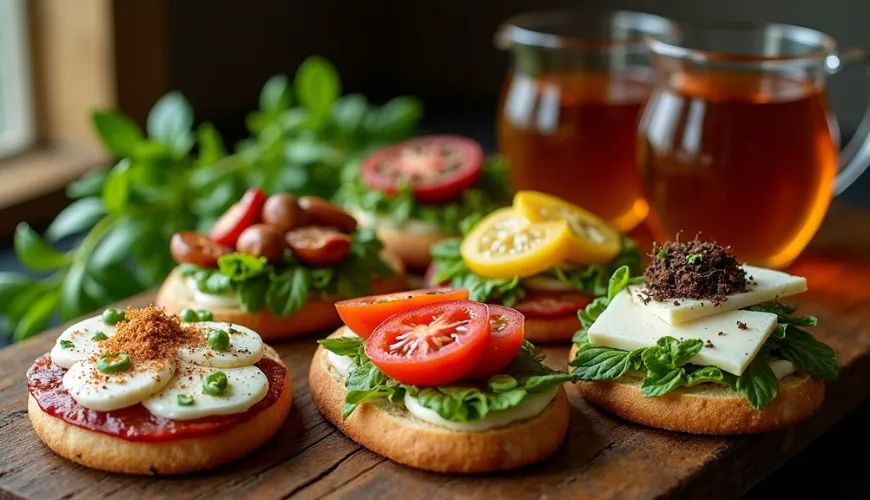
How to Prepare a Delicious Posúch and Surprise Your Home Diners

Posúch - A Traditional Taste that Unites Families and Generations
The aroma of freshly baked bread wafting through the kitchen has the power to evoke memories. Memories of childhood at grandma's, of shared dinners after a Sunday walk, and of moments when the whole house was enveloped in the peaceful anticipation of the first bite. One such treasure of traditional cuisine is posúch – a simple, yet incredibly fragrant flatbread that has evolved into hundreds of varieties over the centuries.
While in the past, posúch was a humble meal for the poor, today it returns to our tables as a delicious treat with a soul. Whether you prefer the classic with garlic or are looking for inspiration in modern variations with tomatoes and cheese, posúch has its place in every kitchen.
What is posúch and where does it come from?
The word "posúch" has its roots in ancient Slavic cuisine. It originates from areas of present-day Slovakia, Moravia, and parts of Hungary, where it was prepared as a quick non-leavened bread – usually from leftover dough from baking bread, which was spread with fat and garlic and baked in the oven directly on a hot stone. In some regions, it's called "pecňák," elsewhere "langoš," but the basic principle remains: flat dough, simple ingredients, and a hearty taste.
Traditional households often baked posúch first when the oven was being heated. This tested its temperature before the main bread was baked. This initially secondary product quickly gained popularity for its crispy crust and soft center, ideal for a quick fill-up.
Basic Recipe for Homemade Posúch
The foundation of any posúch is the dough, which can be bread, leavened, or unleavened. It depends on how much time you have and what you prefer. The classic garlic posúch recipe from leavened dough is simple, doesn't require special ingredients, and can be managed by a beginner.
Classic Garlic Posúch
Ingredients:
- 500 g plain flour
- 1/2 cube fresh yeast (about 20 g)
- 300 ml lukewarm water
- 1 teaspoon sugar
- 1 teaspoon salt
- 2 tablespoons oil (e.g., sunflower or olive oil)
For brushing:
- 4 cloves of garlic
- 3 tablespoons oil
- a pinch of salt
- chopped parsley or rosemary (to taste)
Instructions:
- Mix yeast with sugar in water and let the starter rise.
- Mix flour, salt, and oil, add the starter, and knead into a smooth dough. Let it rise for 45–60 minutes in a warm place.
- Divide the dough into two parts, roll into a circle or oval, and transfer to a baking sheet.
- Bake in an oven preheated to 220°C for about 10–15 minutes until golden.
- Meanwhile, mix oil with pressed garlic and salt.
- Brush the hot posúch with garlic oil and sprinkle with herbs.
The result is fragrant and crispy bread that complements soup, salad, or can serve as a standalone meal.
Pizza Style and Modern Variations
In addition to the classic garlic posúch, there are increasingly modern variations that play with ingredients and final form. One popular adaptation is the so-called pizza posúch, which resembles Italian pizza but with different dough and often a more rustic appearance.
In this version, tomato sauce, cheese, olives, vegetables, or deli meats are added to the dough – according to taste and current availability. Unlike classic pizza, the dough is not as thin, but remains light and fluffy. Such posúch is ideal for a weekend dinner or a festive treat.
An interesting example is a family from southern Moravia, which hosts a "homemade posúch party" every Friday night. Children choose what to put on their piece – some opt for cheese and corn, others garlic with herbs, and perhaps dad can't resist a spicy version with chili and sausage. This form of communal cooking not only brings people together but also teaches children to cook and explore flavor combinations.
Sweet, Vegan, and Gluten-Free Posúch
Although posúch is traditionally savory, it can also be prepared sweet. In some areas of Slovakia, it is baked with poppy seeds, curd cheese, or jams. In such cases, the dough is brushed with butter or vegetable fat and sprinkled with a sweet filling. The resulting taste resembles a cake but is simpler to prepare.
Vegetarians and vegans will appreciate that posúch doesn't have to contain animal products. The dough can be made without milk, butter, or eggs, and garlic oil or herb mixes taste great even without cheese. For a gluten-free version, simply use a mix of gluten-free flours, such as rice, buckwheat, or corn, in combination with psyllium for better structure.
Why Posúch?
Apart from its taste, posúch is also favored for its simplicity and adaptability. You don't need special tools, a bread maker, or ingredients that can only be found in organic stores. You can make do with what you usually have at home. Additionally, it bakes quickly, doesn't require long rising times (not at all for non-leavened versions), and can be managed by someone just starting out with baking.
Compared to regular bread or pizza, posúch has one advantage: it is not bound to a single correct form. It can be thicker or thinner, round or elongated, with or without garlic, with pesto, tomatoes, olives, or simply with a bit of salt and oil. Its form adapts to your current taste and pantry supplies.
What to Serve with Posúch?
While in the past posúch was a standalone meal, today we often see it as a side dish. It pairs well with thick soups, such as cabbage or lentil, grilled dishes, or as a base for sandwiches. It tastes great cold, making it suitable for a school lunchbox or a picnic.
If you're looking for something quick for the evening, a few tablespoons of olive oil, fresh herbs, and a piece of cheese are all you need for a balanced meal without unnecessary effort.
As one Slovak chef said in an interview for the magazine Dobré jedlo: "Posúch is like a little bread with a heart. You can give it whatever you want, and it will return it with a taste that warms you." And perhaps that is the greatest charm of this humble bread.
Whether you choose garlic, pizza, sweet, or gluten-free, posúch is an ideal example of how simplicity can turn into a culinary experience. It's a way to connect the past with the present, tradition with creativity – and most importantly, people at one table.

